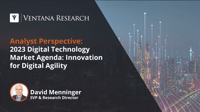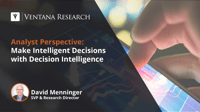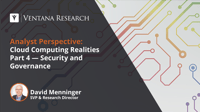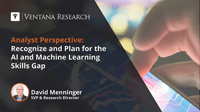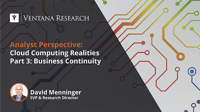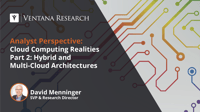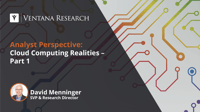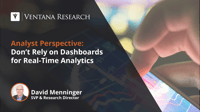I’m proud to share Ventana Research’s 2023 Market Agenda for Digital Technology. Our focus in this agenda is to deliver expertise to help organizations prioritize technology investments that improve customer, partner and workforce experiences while also increasing organizational effectiveness and agility.
Read More
Topics:
Analytics,
Cloud Computing,
Internet of Things,
Data,
Digital Technology,
blockchain,
mobile computing,
extended reality,
AI & Machine Learning,
robotic automation,
Collaborative & Conversational Computing
For far too long, business intelligence technologies have left the rest of the exercise to the reader. Many of these tools do an excellent job providing information in an interactive way that lets organizations dive into the data and learn a lot about what has happened across all aspects of the business. More recently, many of these tools have added augmented intelligence capabilities that help explain why things happened. But rarely did any of these tools provide information about what to do...
Read More
Topics:
business intelligence,
Analytics,
Digital Technology,
AI & Machine Learning,
Analytics & Data
In previous perspectives in this series, I’ve discussed some of the realities of cloud computing including costs, hybrid and multi-cloud configurations and business continuity. This perspective examines the realities of security and regulatory concerns associated with cloud computing. These issues are often cited by our research participants as reasons they are not embracing the cloud. To be fair, the majority of our research participants are embracing the cloud. However, among those that have...
Read More
Topics:
Analytics,
Business Intelligence,
Cloud Computing,
Data Governance,
Digital Technology,
AI & Machine Learning,
Analytics & Data,
Governance & Risk
Recently, I suggested you need to “mind the gap” between data and analytics. This perspective addresses another gap — the gap in skills between business intelligence (BI) and artificial intelligence/machine learning (AI/ML).
Read More
Topics:
Analytics,
Business Intelligence,
Digital Technology,
AI & Machine Learning,
Analytics & Data
In my previous perspectives on cloud computing, I addressed some of the realities of cloud costs as well as hybrid and multi-cloud architectures. In the midst of the pandemic, my colleague, Mark Smith, authored a series of perspectives on considerations for business continuity in general, beginning with this look at some of the investments organizations must make to mitigate the risk of business disruptions. In this perspective, I’d like to address some of the realities of business continuity...
Read More
Topics:
Business Continuity,
Cloud Computing,
Digital Technology,
digital business
In my first perspective on cloud computing realities, I covered some of the cost considerations associated with cloud computing and how the cloud costing model may be different enough from on-premises models that some organizations are taken by surprise. In this perspective. I’d like to focus on realities of hybrid and multi-cloud deployments.
Read More
Topics:
Cloud Computing,
Digital Technology
The migration to cloud is obvious. Organizations are adopting cloud computing for all variety of applications and use cases. Managed cloud services, commonly referred to as software as a service (SaaS), offer many benefits to organizations including significantly reduced labor costs for system administration and maintenance, as many of these costs are shifted to the software vendor. SaaS also provides organizations with faster time to value as they adopt new technologies by eliminating the need...
Read More
Topics:
Cloud Computing,
Digital Technology
I have written previously that the world of data and analytics will become more and more centered around real-time, streaming data. Data is created constantly and increasingly is being collected simultaneously. Technology advances now enable organizations to process and analyze information as it is being collected to respond in real time to opportunities and threats. Not all use cases require real-time analysis and response, but many do, including multiple use cases that can improve customer...
Read More
Topics:
Analytics,
Business Intelligence,
Internet of Things,
Data,
Digital Technology,
Streaming Analytics,
AI & Machine Learning,
Analytics & Data,
Streaming Data & Events
For years, maybe decades, we have heard about the struggles between IT and line-of-business functions. In this perspective, we will look at some of the data from our Analytics and Data Benchmark Research about the roles of IT and line-of-business teams in analytics and data processes. We will also look at some of the disconnects between these two groups. And, by looking at how organizations are operating today and the results they are achieving, we can discern some of the best practices for...
Read More
Topics:
Analytics,
Business Intelligence,
Data,
Digital Technology,
AI & Machine Learning,
Analytics & Data
